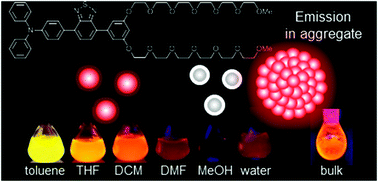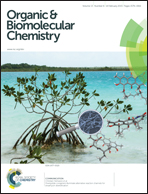Amphiphilic benzothiadiazole–triphenylamine-based aggregates that emit red light in water†
Abstract
In this study, we report a preparation and an aggregate emission behavior of an amphiphilic donor–acceptor dye, which is composed of a triphenylamine–benzothiadiazole donor–acceptor chromophore and two water-soluble hexa(ethylene glycol) chains. The dye is strongly fluorescent in nonpolar solutions such as cyclohexane and toluene, whereas the emission intensity is reduced in aprotic polar solutions such as DMF and acetonitrile. This fluorescence reduction correlates with the increase in polarity, by which the transition from a local excited state to a highly polarized excited state is facilitated, leading to an increased nonradiative deactivation rate. Furthermore, significant fluorescence quenching is observed in protic polar solutions such as ethanol and methanol. Hydrogen-bonding interactions between the dye and the protic solvent molecules further accelerate the deactivation rate. In contrast, in a water solution, red light emission is achieved distinctly at 622 nm with a relatively large fluorescence quantum yield of 0.20. This red emission is related to the aggregation of the dye molecules grown in water. The kinetic analysis from the fluorescence rate constant and nonradiative rate constant indicates that the nonradiative deactivation channel is restricted in water. The formed aggregate, which was indicated by transmittance electron microscopy as a spherical aggregate morphology with a diameter of 3–4 nm, provides a less polar hydrophobic space inside the aggregate structure, by which hydrogen-bonding and the subsequent quenching are restricted, leading to the reduction of the nonradiative deactivation rate.

- This article is part of the themed collection: In celebration of Seiji Shinkai's 70th Birthday

 Please wait while we load your content...
Please wait while we load your content...